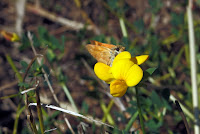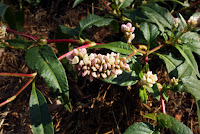 As our very dry summer continues to keep our local meteorologists busy tabulating data, the rest of us try to spend as much time outdoors as possible. But even to the casual nature lover, the dry state of our local parks and trails is obvious. In particular, we visit Jackson Bottom Wetlands Preserve on a regular basis all year because it is nearby and offers good walking trails. This time of year in mid-September it is normally fairly dry at the preserve, but this year takes the proverbial cake in terms of dryness. The ponds are usually just starting to dry out now, but this year they are long since dried out.
As our very dry summer continues to keep our local meteorologists busy tabulating data, the rest of us try to spend as much time outdoors as possible. But even to the casual nature lover, the dry state of our local parks and trails is obvious. In particular, we visit Jackson Bottom Wetlands Preserve on a regular basis all year because it is nearby and offers good walking trails. This time of year in mid-September it is normally fairly dry at the preserve, but this year takes the proverbial cake in terms of dryness. The ponds are usually just starting to dry out now, but this year they are long since dried out.The Pintail pond shown above on the left looks like the Dead Sea and the Bobcat Marsh pond on the right, had a good weed crop going at this point. Only the North pond still has a bit of water, and that's where I saw the egret and geese.
 |
| North Pond and Nodding Beggarticks |
That said, on a recent outing at the preserve (9/08/2015), we were amazed at both the dryness of the marshy areas as well as some of the remaining plant life. It was no surprise that we did not spot any waterfowl to speak of except for a stray Great Egret and a couple of geese.
On the other hand, nearly every step along the trail released dozens of crickets from their resting places. I mean, we are talking a cricket big bang here folks, with possibly millions of the little musicians hanging out here. There were a few songbirds moving through the areas with trees, and no doubt picking off a few of the crickets.
Also surprising was the number of plants still hanging in there with blooms. The most widespread blooming plant at this time was the native Nodding Beggarticks, which seems to be taking over a large swath near the north pond. Next in line, by general observation, was the Willamette Valley Gumweed, another native that prefers wet meadows.
The rest of the blooms shown below were growing here and there, and were still attracting insects. So was I for that matter, but nothing was biting me! Mouse over or tap the thumbnails below for plant identification; the * means the plant is not native to our area.
And finally, for a chuckle, get on Google and search for "How dry is it? jokes." :-)




















